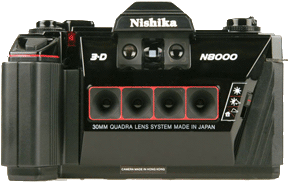
Approx. dates of manufacture: 1988 - 1994
Approx. original price: $200
Approx. street value: very low
When I was starting the research to write this, I was surprised that I couldn't find much about it, considering how recently the camera was produced. So anything I have to say is just personal knowledge and experience, and whatever else I could pick up from the net.
When Nimslo went under in the late 80s, there was a quiet period and then this camera appeared. I believe the company acquired the patents and tooling to produce the camera and decided to make their own version of it (which has been known to happen from time to time. The Ciro 35 was made by three different companies, and it was pretty much the same camera throughout). It would have been interesting to be in on their marketing meetings, though. It's one thing to take over a camera that's a success, or one that you think should be a success if it were simply tweaked and properly marketed. But could the old Nimslo really have found fame and fortune without redoing everything from scratch? Nishika obviously thought so, but I have no clue why.
So anyway, in the late 80s or so they came out with their N8000. At first glance it looks like a big, upscale version of the little point and shoot Nimslo. The four lenses up front look about identical, but the rest of the camera is much larger and beefier-looking. Unfortunately, a closer look doesn't do it any favors. The body was plastic, wheras the Nimslo was metal. It was much larger but it still took 35mm film and the images weren't any larger, so it didn't exactly tuck into a pocket or purse nicely. It had a nice hump out front that looked like a built-in film winder, but it just turned out to be the battery compartment for the meter—you still had to manually advance the film with the thumb-winder on top. The back had a nice rubberized cover that made it comfortable to hold, but humps and bulges were all for show. Probably the worst was the "LCD"-like panel on the top. It looked good at a distance, but closer inspection revealed that it simply suggested optimum distances for 3D photos.
Someone on a website claimed that they put a lead weight in the bottom of it to make it feel more substantial. I haven't taken the camera apart so I don't know that for a fact, but as I look at the plastic and feel the camera, I don't doubt it a bit.
My favorite "feature" is the "easy to use variable aperture for optimum exposure," which meant you had to set the aperture yourself to one of three vague positions that translated to nothing in the real world. No shutter speed adjust, and no film-speed setting. The meter probably only warned of low light conditions (amazing considering there's no way to tell the camera the film speed).
Another dubious accessory was its "twin-light flash," which is simply a bounce flash with a built-in fill light. It did attach via the hot-shoe, however. Even Nishika didn't expect its users to plug in a synch cord.
To make this more attractive they did offer a VHS videotape of Vincent Price, star of the most famous 3-D film, the awful "House of Wax." They figured people who wouldn't read instruction manuals would be happy to watch Vincent Price demo the camera instead (not a bad idea, actually). I've got the videotape but I haven't watched it yet.
If they'd sold it at a reasonable price it might have done something, but I remember it coming out at around $200 and I was shocked anyone would buy it, particularly since at that time you could still get a brand new, in-the-box Nimslo for around $50, tops.
Mine came with a roll of film already in it, mostly shot but I tossed it. I'm tired of paying to have other people's pictures developed, especially since they always seem god-awful.
Camera manual: Orphan Cameras.com



